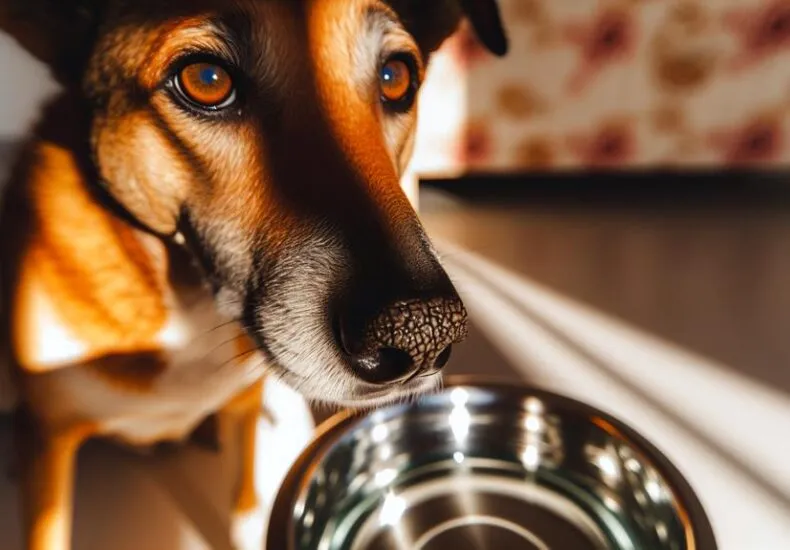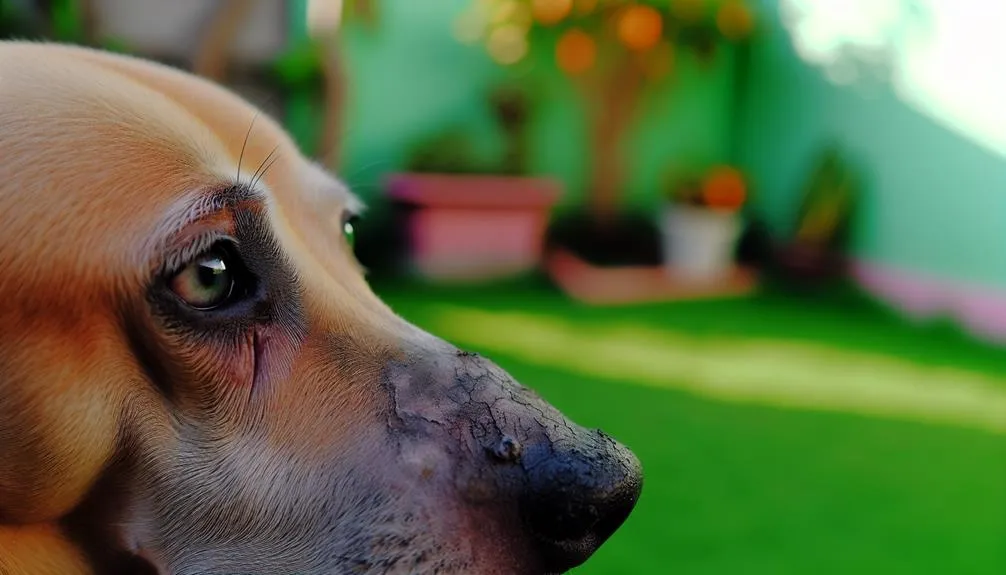
Why Is My Dogs Nose Dry
Imagine you've just taken your dog for a long walk on a chilly day, only to notice that their nose feels unusually dry when you get home. It's a common observation among pet owners, but it raises important questions about what could be causing this change. Is it simply the weather, or could there be more at play? Understanding the various factors that contribute to a dog's nose moisture not only helps you address your concerns but also guarantees you're aware of when a dry nose might signal a need for veterinary care.
Normal Variations in Moisture
The moisture level of a dog's nose can vary considerably throughout the day and is influenced by several factors. Understanding the dog nose anatomy is essential to grasping these normal variations in moisture. A dog's nose is made up of specialized skin and mucous membranes that help to regulate temperature and humidity levels. The moisture levels in the nose are generally highest right after your dog wakes up, as the overnight resting period allows for natural hydration.
As your dog becomes active throughout the day, the moisture can decrease due to environmental factors like temperature and humidity, as well as physical activity. Dogs use their noses not just for smell but also for thermoregulation. As the day progresses and your dog moves around, the moisture levels can fluctuate, reflecting their physical state and activity level.
Additionally, certain breeds may have more pronounced variations in moisture due to their unique dog nose anatomy. For instance, Brachycephalic breeds might experience quicker changes in moisture levels due to the structure of their noses.
It's important to remember that a dry nose isn't inherently a sign of illness; it could simply be a normal variation in moisture levels. Monitoring these changes can help you determine if your dog's nose is operating within a typical range. By staying aware of these fluctuations, you can better gauge your dog's overall health and well-being.
Environmental Factors
Variations in your dog's nose moisture can greatly be affected by environmental factors. One of the primary influences is humidity levels. In environments with low humidity, your dog's nose may become dry and less moist. This is particularly common during the colder months when indoor heating systems are in use, reducing the moisture content in the air. Significantly, when humidity levels drop below 30%, you might observe a more pronounced dryness in your dog's nose.
Seasonal changes also play an essential role in this phenomenon. In the summer, high humidity levels often create a more conducive environment for moisture retention, resulting in a wetter nose. Conversely, as autumn shifts into winter, the drop in temperature combined with reduced humidity can lead to increased dryness. Seasonal variations can cause fluctuations in your dog's hydration levels as well, impacting both overall health and nose moisture.
Moreover, outdoor activities can contribute to changes in nose moisture. For instance, if your dog spends time in windy or arid conditions, the exposure can exacerbate dryness. Similarly, if your dog frequently shifts between different environments, such as from humid outdoors to dry indoors, you might notice variations in their nose moisture.
Health Issues to Consider

Evaluating health issues can be crucial when assessing a dog's dry nose. A dry nose may not just be a harmless occurrence; it can signal underlying health concerns that require attention. One significant factor to reflect on is dehydration. Dogs can exhibit dehydration symptoms such as lethargy, dry gums, and decreased skin elasticity. If your dog's nose is dry alongside these symptoms, you may need to assess their water intake and overall hydration status.
Another important aspect to take into account is the dog's immune response. A compromised immune system can lead to skin conditions and infections, which can manifest as a dry, cracked nose. Conditions like autoimmune disorders can also affect the moisture levels of your dog's nasal area. If you notice other signs, such as changes in behavior, appetite, or energy levels, it's crucial to consult a veterinarian.
Additionally, certain illnesses, like canine distemper or infections, can impact the moisture of your dog's nose. Keeping an eye on any accompanying symptoms—be it coughing, vomiting, or unusual discharge—can help you identify if a visit to the vet is warranted. While a dry nose can be a minor issue, it's important to remain vigilant about your dog's health. If you suspect a health problem, don't hesitate to seek professional advice to guarantee your furry friend's well-being.
Breed-Specific Characteristics
Different dog breeds exhibit unique characteristics that can influence the moisture levels of their noses. The relationship between breed tendencies and coat type plays a significant role in how your dog's nose maintains moisture. For instance, breeds with thicker coats may have a higher tendency for dry noses, especially in dry climates. Understanding these breed-specific traits can help you monitor your dog's health more effectively.
Here's a table that illustrates how different breeds may be affected by these factors:
| Dog Breed | Coat Type |
|---|---|
| Labrador Retriever | Short, Dense |
| Shih Tzu | Long, Silky |
| Siberian Husky | Double Coat |
| Greyhound | Short, Smooth |
| Bulldog | Short, Fine |
As you can see, each breed has its unique coat type, which can influence the moisture levels of their noses. Breeds with shorter, denser coats, like the Labrador Retriever, may have noses that stay moist due to less exposure to environmental conditions. In contrast, breeds with long, silky fur, such as the Shih Tzu, may experience more moisture loss due to the greater surface area exposed.
When to See a Veterinarian

A dry nose in dogs can be a common occurrence, but it's vital to know when it signals a potential health issue that requires veterinary attention. While some dogs may simply have variations in nose moisture due to environmental factors or breed characteristics, certain symptoms warrant closer scrutiny.
Start with a thorough symptom assessment. If your dog's nose remains persistently dry and is accompanied by other signs such as lethargy, loss of appetite, vomiting, diarrhea, or unusual behavior, it's important to consult your veterinarian. These could be indicators of underlying health problems like dehydration, fever, or autoimmune diseases.
Additionally, if you observe any changes in the texture or color of your dog's nose—such as cracking, scaling, or bleeding—seek veterinary advice promptly. These changes might suggest skin infections, allergies, or even more serious conditions like nasal tumors.
Moreover, if your dog frequently licks or rubs its nose excessively, it could indicate discomfort or irritation, which should also be evaluated by a professional. Remember, early intervention can greatly improve outcomes and prevent complications.
Frequently Asked Questions
Can a Dry Nose Indicate Allergies in Dogs?
Yes, a dry nose can indicate allergies in dogs. You should observe other allergy symptoms, like itching or sneezing, and consider environmental factors that might trigger these reactions. Consult your vet for accurate diagnosis and treatment.
How Can I Keep My Dog's Nose Moist?
To keep your dog's nose moist, consider using nose moisturizing products specifically designed for canines. Incorporate hydration techniques like ensuring adequate water intake and applying coconut oil or shea butter for added moisture and protection.
Do Certain Foods Affect My Dog's Nose Moisture?
Absolutely, certain foods can influence your dog's nose moisture. Balanced nutrition and hydration are key; dry kibble may dehydrate. Incorporating moist foods enhances hydration, creating a harmonious balance for your dog's overall health and comfort.
Is a Dry Nose Common in Older Dogs?
Yes, a dry nose can be common in older dogs due to aging factors and potential health conditions. It's important to monitor any changes and consult your vet for a thorough evaluation and guidance.
Can Stress Cause a Dog's Nose to Become Dry?
Yes, stress can cause a dog's nose to become dry. Stress symptoms often lead to decreased hydration levels, affecting moisture in the nose. Monitoring your dog's behavior can help identify and address underlying stress factors effectively.
Conclusion
So, if your dog's nose is drier than a desert, don't panic—unless they start acting like a drama queen! A little dryness can be normal, thanks to the whims of weather or playtime. Just don't ignore it if they're also giving you those "I feel awful" puppy eyes. Keep an eye out for other symptoms, and if in doubt, consult a vet. After all, even dogs deserve a little pampering when their noses are parched!
You may also like
Archives
Calendar
| M | T | W | T | F | S | S |
|---|---|---|---|---|---|---|
| 1 | 2 | 3 | 4 | 5 | 6 | |
| 7 | 8 | 9 | 10 | 11 | 12 | 13 |
| 14 | 15 | 16 | 17 | 18 | 19 | 20 |
| 21 | 22 | 23 | 24 | 25 | 26 | 27 |
| 28 | 29 | 30 | ||||
Leave a Reply